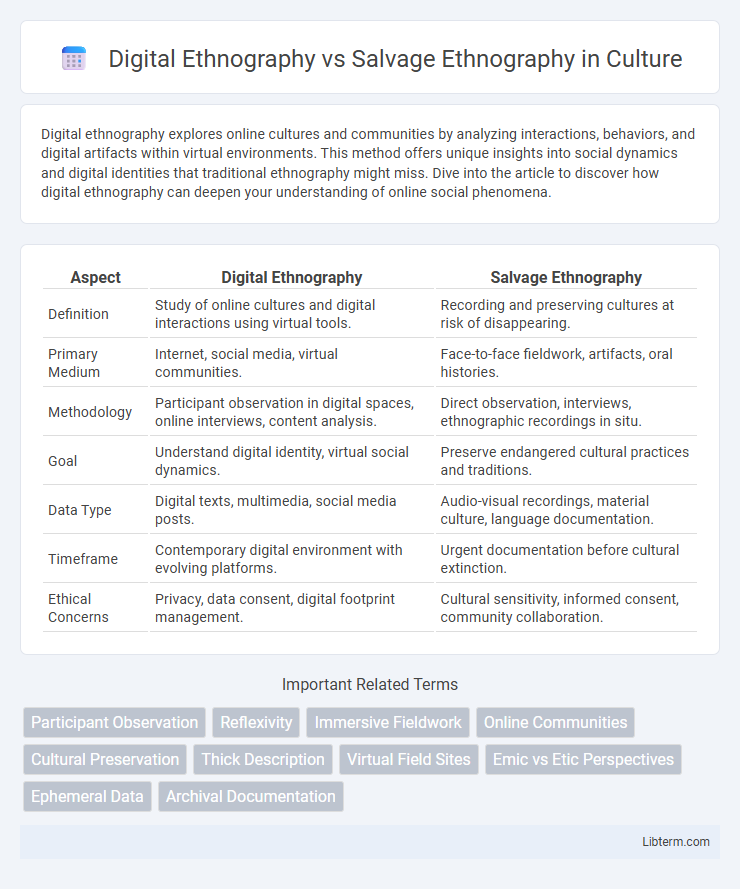Digital ethnography explores online cultures and communities by analyzing interactions, behaviors, and digital artifacts within virtual environments. This method offers unique insights into social dynamics and digital identities that traditional ethnography might miss. Dive into the article to discover how digital ethnography can deepen your understanding of online social phenomena.
Table of Comparison
| Aspect | Digital Ethnography | Salvage Ethnography |
|---|---|---|
| Definition | Study of online cultures and digital interactions using virtual tools. | Recording and preserving cultures at risk of disappearing. |
| Primary Medium | Internet, social media, virtual communities. | Face-to-face fieldwork, artifacts, oral histories. |
| Methodology | Participant observation in digital spaces, online interviews, content analysis. | Direct observation, interviews, ethnographic recordings in situ. |
| Goal | Understand digital identity, virtual social dynamics. | Preserve endangered cultural practices and traditions. |
| Data Type | Digital texts, multimedia, social media posts. | Audio-visual recordings, material culture, language documentation. |
| Timeframe | Contemporary digital environment with evolving platforms. | Urgent documentation before cultural extinction. |
| Ethical Concerns | Privacy, data consent, digital footprint management. | Cultural sensitivity, informed consent, community collaboration. |
Introduction to Ethnography: Digital vs. Salvage
Digital ethnography leverages online environments to study contemporary cultures and social interactions, offering real-time access to dynamic digital communities and virtual behaviors. Salvage ethnography focuses on documenting and preserving traditional cultures at risk of disappearing, emphasizing in-depth fieldwork and detailed recordings of languages, rituals, and customs. Both methodologies contribute essential knowledge but diverge in scope, tools, and the cultural contexts they aim to represent.
Defining Digital Ethnography
Digital Ethnography involves immersive research within online communities and virtual environments to observe and analyze cultural practices, behaviors, and interactions through digital platforms. It leverages tools like social media analysis, virtual fieldwork, and digital communication tracking to capture contemporary social dynamics. Salvage Ethnography, by contrast, focuses on documenting endangered cultures and traditions before they disappear, often through in-person fieldwork and artifact collection.
Understanding Salvage Ethnography
Salvage ethnography is a method focused on documenting and preserving cultures perceived to be disappearing due to rapid modernization or colonization, typically involving immersive fieldwork and detailed recording of rituals, language, and artifacts. Unlike digital ethnography, which leverages online platforms and digital tools to study contemporary cultural interactions in virtual environments, salvage ethnography prioritizes physical presence and firsthand data collection in threatened indigenous or traditional communities. Understanding salvage ethnography highlights its role in cultural preservation and historical documentation, capturing knowledge that might otherwise be lost to future generations.
Historical Contexts of Both Approaches
Digital ethnography emerged in the early 21st century alongside the rise of the internet and social media platforms, allowing researchers to study online communities and digital cultures in real time. Salvage ethnography originated in the late 19th and early 20th centuries, driven by anthropologists like Franz Boas aiming to document indigenous cultures perceived to be disappearing due to colonialism and modernization. While salvage ethnography prioritized the preservation of traditions through physical artifacts and extensive field notes, digital ethnography leverages virtual environments and digital communication as central sites for cultural analysis.
Research Methods: Digital vs. Salvage Techniques
Digital ethnography employs advanced online tools such as virtual participant observation, social media analysis, and digital content mining to study cultural phenomena in virtual spaces. Salvage ethnography relies on traditional fieldwork methods like interviews, artifact collection, and direct observation to preserve vanishing cultural practices. The contrast between digital techniques and salvage methods highlights the shift from physical immersion in endangered communities to immersive data collection within digital environments.
Data Collection in Online and Disappearing Cultures
Digital ethnography employs immersive data collection methods within online communities, utilizing tools such as digital interviews, participant observation in virtual spaces, and analysis of social media interactions to capture evolving cultural practices. Salvage ethnography focuses on documenting disappearing cultures through intensive fieldwork, recording oral histories, rituals, and artifacts before complete cultural loss occurs. Both methods prioritize capturing authentic cultural data, with digital ethnography emphasizing dynamic, real-time online interactions, while salvage ethnography centers on preserving endangered offline traditions.
Ethical Considerations and Challenges
Digital ethnography presents unique ethical considerations such as ensuring informed consent, maintaining participant privacy in online spaces, and addressing data security in virtual environments. Salvage ethnography faces challenges related to the potential exploitation of endangered cultures, the risk of misrepresentation, and the ethical dilemma of documenting traditions without disrupting or appropriating them. Both approaches require careful navigation of researcher-participant relationships to uphold respect, authenticity, and cultural sensitivity.
Case Studies: Digital and Salvage Ethnography in Practice
Digital ethnography uses online platforms to study contemporary cultures, as seen in studies of social media communities analyzing identity construction and communication patterns. Salvage ethnography documents disappearing cultures through fieldwork, exemplified by early 20th-century efforts to record Native American languages and rituals before their extinction. Case studies highlight digital ethnography's adaptability in rapidly changing virtual spaces, while salvage ethnography emphasizes preservation of endangered traditions through meticulous archival collection.
Impact on Knowledge Production and Representation
Digital ethnography leverages online environments to capture evolving cultural practices, enhancing real-time data collection and broadening representation through diverse digital communities. Salvage ethnography traditionally aims to document endangered cultures, often producing static, archival records that may unintentionally freeze dynamic identities and limit contemporary interpretations. The impact on knowledge production varies as digital ethnography fosters more interactive, participatory narratives, while salvage ethnography emphasizes preservation but risks cultural essentialism and diminished local agency.
Future Trajectories in Ethnographic Research
Digital ethnography harnesses online platforms and virtual communities to capture evolving social behaviors, emphasizing adaptability to rapid technological changes and increasing data complexity. Salvage ethnography concentrates on documenting endangered cultures and practices, prioritizing preservation amid accelerating globalization and cultural loss. Future trajectories in ethnographic research will likely integrate digital tools with traditional salvage methods, fostering hybrid approaches that enhance cultural documentation and analysis in dynamic, digital, and physical environments.
Digital Ethnography Infographic

 libterm.com
libterm.com